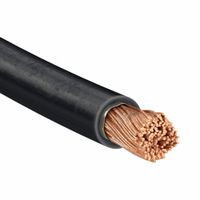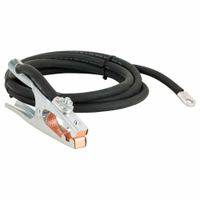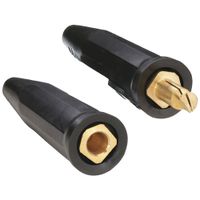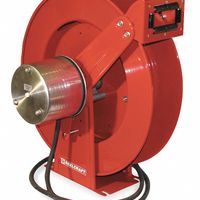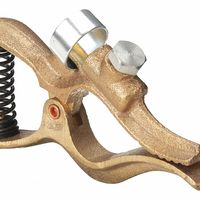Call +(254) 703 030 000 / 751 483 999 / 721 704 777
- Home
- Welding
- Arc Welding
- Welding Cable Connectors Cable Grounds
.....Read More
Frequently Asked Questions
What size welding cable do I need for my welder?
To determine the appropriate size of welding cable for your welder, consider the following factors:
1. **Amperage Rating**: Identify the maximum amperage your welder will use. This information is typically found in the welder's manual or on the machine itself.
2. **Duty Cycle**: Consider the duty cycle of your welder, which is the percentage of time the welder can operate at a given amperage without overheating. A higher duty cycle may require a larger cable to handle increased heat.
3. **Cable Length**: Measure the distance from the welder to the workpiece. Longer cables require larger diameters to minimize voltage drop and maintain performance.
4. **Cable Insulation**: Ensure the cable insulation is rated for the environment and temperature conditions in which you will be welding.
5. **Voltage Drop**: Aim to keep voltage drop below 4% to ensure efficient operation. Larger cables reduce resistance and voltage drop.
6. **Cable Size Chart**: Use a welding cable size chart to match the amperage and length requirements. For example, a 100-amp welder with a 50-foot cable might require a 4 AWG cable, while a 200-amp welder with the same length might need a 2 AWG cable.
7. **Safety and Regulations**: Follow any local electrical codes and safety standards, which may dictate minimum cable sizes.
By considering these factors, you can select the appropriate welding cable size to ensure safe and efficient operation of your welder.
How do I properly connect a welding ground clamp?
To properly connect a welding ground clamp, follow these steps:
1. **Select the Right Clamp**: Choose a ground clamp that matches the amperage of your welding machine and is suitable for the material you are working with.
2. **Inspect the Clamp and Cable**: Ensure the clamp and cable are in good condition, free from damage, corrosion, or wear. A clean, well-maintained clamp ensures better conductivity.
3. **Identify the Grounding Point**: Choose a clean, bare metal surface on the workpiece or welding table as the grounding point. Avoid painted, rusted, or dirty surfaces as they can impede electrical conductivity.
4. **Clean the Grounding Area**: Use a wire brush or grinder to remove any paint, rust, or debris from the grounding area to ensure a solid electrical connection.
5. **Attach the Clamp**: Open the clamp and securely attach it to the cleaned grounding point. Ensure the clamp is tight and stable to prevent it from slipping during welding.
6. **Check the Connection**: Tug gently on the clamp to ensure it is firmly attached. A loose connection can lead to poor weld quality and potential safety hazards.
7. **Position the Cable**: Arrange the ground cable to avoid tripping hazards and ensure it does not come into contact with hot surfaces or moving parts.
8. **Test the Setup**: Before starting to weld, check the setup by performing a test weld on a scrap piece of metal to ensure the ground connection is effective.
9. **Monitor During Welding**: Periodically check the clamp during welding to ensure it remains secure and the connection is maintained.
By following these steps, you ensure a safe and effective welding process with a reliable ground connection.
What are the best welding cable connectors for heavy-duty use?
The best welding cable connectors for heavy-duty use are those that offer durability, reliability, and efficient conductivity. Here are some top choices:
1. **Tweco Connectors**: Known for their robust construction, Tweco connectors are a popular choice in industrial settings. They feature a brass body for excellent conductivity and durability, and their cam-lock design ensures a secure connection.
2. **Dinse Connectors**: These are widely used in Europe and are appreciated for their compact design and high current capacity. Dinse connectors are made from high-quality materials that withstand high temperatures and mechanical stress, making them ideal for heavy-duty applications.
3. **Lenco Connectors**: Lenco offers a range of heavy-duty connectors that are designed to handle high amperage. Their connectors are made from solid brass and feature a secure locking mechanism to prevent accidental disconnection.
4. **Miller Connectors**: Miller's heavy-duty connectors are designed for high-performance welding applications. They are made from durable materials and feature a quick-connect design for easy installation and removal.
5. **Hubbell Connectors**: Known for their rugged design, Hubbell connectors are suitable for demanding environments. They offer excellent electrical performance and are resistant to corrosion and wear.
6. **Cam-Lok Connectors**: These connectors are often used in industrial and construction settings due to their high current capacity and secure locking mechanism. They are made from durable materials and are designed to withstand harsh conditions.
When selecting welding cable connectors for heavy-duty use, consider factors such as the amperage rating, material quality, ease of connection, and environmental resistance. These connectors should provide a reliable and efficient connection to ensure safety and performance in demanding welding applications.
How do I choose the right welding cable reel for my setup?
To choose the right welding cable reel for your setup, consider the following factors:
1. **Cable Size and Length**: Determine the gauge and length of the welding cable you need. The reel must accommodate the cable's diameter and length without causing damage or excessive tension.
2. **Current Rating**: Ensure the reel can handle the maximum current your welding setup requires. Check the reel's amperage rating to match your welding machine's output.
3. **Reel Type**: Decide between manual, spring-driven, or motorized reels. Manual reels are cost-effective but require more effort. Spring-driven reels offer automatic retraction, while motorized reels provide ease of use for heavy cables.
4. **Durability and Material**: Choose a reel made from durable materials like steel or heavy-duty plastic to withstand harsh environments. Consider corrosion resistance if used outdoors or in humid conditions.
5. **Mounting Options**: Determine where and how you will mount the reel. Options include wall, ceiling, or floor mounting. Ensure the mounting method suits your workspace layout and accessibility needs.
6. **Swivel Base**: A swivel base allows the reel to rotate, providing flexibility and reducing cable wear. This feature is beneficial for setups requiring frequent movement.
7. **Safety Features**: Look for reels with safety features such as locking mechanisms to prevent accidental unwinding and cable guides to ensure smooth retraction.
8. **Budget**: Balance your needs with your budget. While higher-end reels offer more features and durability, ensure it aligns with your financial constraints.
9. **Brand and Warranty**: Consider reputable brands known for quality and reliability. Check the warranty for assurance and support in case of defects or issues.
By evaluating these factors, you can select a welding cable reel that enhances efficiency, safety, and longevity in your welding operations.
What is the difference between welding cable lugs and connectors?
Welding cable lugs and connectors serve distinct purposes in electrical and welding applications, though both are used to establish secure electrical connections.
Welding cable lugs are terminal ends used to connect welding cables to welding machines, power sources, or other equipment. They are typically made from copper or aluminum to ensure excellent conductivity and are designed to handle high current loads. Lugs are often crimped or soldered onto the cable, providing a secure and permanent connection. They come in various sizes to accommodate different cable gauges and are often used in environments where durability and reliability are critical.
Connectors, on the other hand, are devices used to join two or more electrical circuits together. In the context of welding, connectors are used to join welding cables to each other or to equipment. They are designed to be easily connected and disconnected, allowing for flexibility and mobility in welding operations. Connectors can be made from various materials, including plastic and metal, and often feature locking mechanisms to ensure a secure connection. They are typically used in applications where frequent disconnection and reconnection are necessary.
In summary, the primary difference lies in their application and design: lugs provide a permanent connection for high-current applications, while connectors offer a flexible, temporary connection that can be easily engaged and disengaged.
How do I maintain and store welding cables to prevent damage?
To maintain and store welding cables effectively, follow these guidelines:
1. **Regular Inspection**: Frequently check cables for signs of wear, cuts, or abrasions. Look for exposed wires or damaged insulation, which can lead to electrical hazards.
2. **Proper Coiling**: Coil cables loosely to prevent kinks and tangles. Use the over-under technique to maintain the cable's natural lay and avoid twisting.
3. **Cleanliness**: Keep cables clean from dirt, oil, and other contaminants. Wipe them down with a dry or slightly damp cloth after use to prevent buildup that can degrade the insulation.
4. **Avoid Sharp Bends**: Do not bend cables sharply or force them into tight spaces. This can damage the internal conductors and insulation.
5. **Storage Conditions**: Store cables in a cool, dry place away from direct sunlight, moisture, and extreme temperatures. Use cable racks or hooks to hang them off the ground, preventing contact with potentially damaging surfaces.
6. **Protection from Physical Damage**: Avoid running cables across high-traffic areas where they can be stepped on or run over. Use cable protectors or ramps if crossing pathways is unavoidable.
7. **Avoid Overloading**: Ensure cables are rated for the current they will carry. Overloading can cause overheating and damage the cable.
8. **Secure Connections**: Ensure all connections are tight and secure to prevent arcing, which can damage both the cable and the welding equipment.
9. **Use Cable Covers**: In environments where cables are exposed to potential mechanical damage, use protective covers or conduits.
10. **Regular Maintenance**: Schedule regular maintenance checks by a professional to ensure cables remain in good working condition and replace any damaged sections immediately.
Can I use regular electrical connectors for welding cables?
No, regular electrical connectors are not suitable for welding cables. Welding cables carry high currents and are subject to intense heat and mechanical stress, which regular connectors are not designed to handle. Using inappropriate connectors can lead to overheating, increased resistance, and potential failure, posing safety hazards such as electrical fires or equipment damage. Instead, specialized welding connectors, such as DINSE or Tweco connectors, should be used. These are designed to accommodate the high current and thermal demands of welding applications, ensuring a secure and efficient connection.
